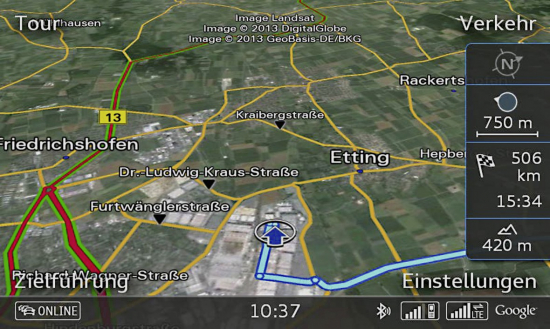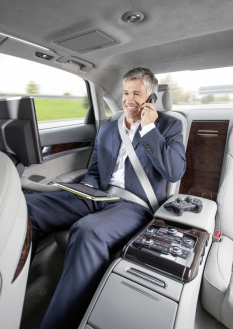LTE
The cellular phone network is key global factor for the networking of automobiles. In most countries, mobile device data are transferred via UMTS networks (UMTS = Universal Mobile Telecommunications System). Depending on the configuration, the third generation (3G) of this mobile communications standard currently enables a transfer rate of up to 21 Mbit per second.
LTE networks (LTE = Long Term Evolution) are already available in several European countries and the United States. In Germany, the fourth-generation mobile communications standard is already active in all major cities and in rural areas. Audi brought LTE technology to the automobile in 2013: the latest generation LTE Audi connect module is used in the models of the A3 family (Combined fuel consumption in l/100 km: 6.5 – 3.2; Combined CO2-emissions in g/km: 149 - 85)**. Further model lines will follow in the near future.
The fully integrated LTE module supports data rates of up to 100 Mbit/s downstream, 50 Mbit/s upstream and very short response times. This enables the transfer of large volumes of data, such as music and high-definition films, as well as short ping times for interactive applications such as games. Passengers in the new Audi A3 can run different applications at the same time on their mobile devices. One of them can participate in a conference call, for example, while another watches a video.
Thanks to the full integration of the module, it is not just mobile end devices that benefit from the high-speed receiver technology. It was important during the development process to not only provide a high-speed Internet connection mobile devices, but also to provide high-speed Internet access for the car’s internal systems. This enables Audi connect services such as navigation with Google Earth and Google Street View to load and display much, much faster.
Full integration of LTE and the associated fast transfer of data will enable the targeted expansion of the Audi connect range in the years ahead, from cloud-based music services to car-to-X services such as wireless payment or communication with traffic signals. LTE makes it possible to provide these services everywhere, even in rural areas.
**Figures depend on the tires/wheels used.
Status: 1/2014

